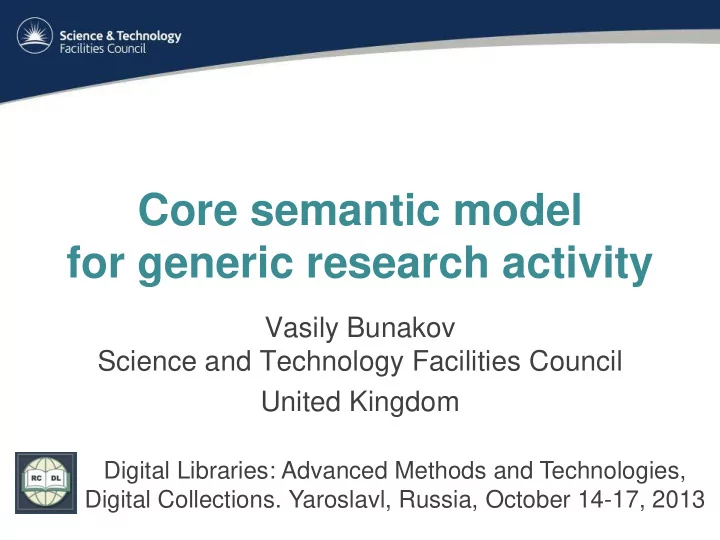

Core semantic model for generic research activity Vasily Bunakov Science and Technology Facilities Council United Kingdom Digital Libraries: Advanced Methods and Technologies, Digital Collections. Yaroslavl, Russia, October 14-17, 2013
STFC Funds and operates large scale instruments for the UK and visitor researchers in: - physics, astronomy - chemistry, materials - biology, medicine Scientific Computing develops and operates computing infrastructure: - High Performance Computing - Petabyte data store - CERN LHC Tier 1 hub also conducts applied research and does software development
Big Facilities for Small Science ISIS neutron and muon source Central Laser Facility Facilities Support Diamond Light Source
PaNdata projects PaNdata Europe 2010 – 2011 Preparation: common policies and standards http://pan-data.eu/pandata/?q=PaNdataEurope PaNdata ODI 2011 – 2014 Implementation: delivering new infrastructure http://pan-data.eu/pandata/?q=ODIWP
Facilities Research Lifecycle Record Proposal Publication Subsequent Approval publication Data registered with analysis facility Scientist submits application for Scheduling beamtime Data storage Experiment Tools for processing made Raw data filtered, Facility committee available and stored approves Scientists visits, Facility registers, facility run’s application trains, and experiment schedules scientist’s visit Data catalogue software: http://code.google.com/p/icatproject/
CSMD: Core Scientific MetaData Model Topic Publication Keyword Authorisation Investigation Investigator Sample Dataset Sample Parameter CSMD forms the information model for Dataset facilities data catalogues Datafile Parameter Parameter Datafile Related Datafile Parameter
We joined DataCite Much cheaper DOIs than directly from DOI Foundation www.DataCite.org
Is it really about data? Our DOIs landing pages are in fact for Investigations (Experiments) Red is for “data” notion, and green is for “investigation ” LCDP 2013
We are not alone in DataCite “abuse”
We used to think our metadata is for “data” but in fact, quite often it is for “activity”, e.g. Experiment or Study
Research activity is not restricted to Experiment or Study and can be a part of a longer “value chain” DDI record for social science Study decomposed Archives: www.data-archive.ac.uk www.gesis.org and many more DDI portal: www.ddialliance.org Project: www.engage-project.eu Platform: www.engagedata.eu
ENGAGE vision: promotion of Open Data to Linked Open Data through collaborative data curation Project: www.engage-project.eu Platform: www.engagedata.eu
To make research data linkable, we need to reasonably model research activity • Keep the model generic enough • Keep it simple for better adoption and “opportunistic” application • Aim it not at humans only but at machines / software agents, too
Do we have reasonable research activity models? DARIAH Scholarly Research Activity I2S2 Scientific Research Activity Lifecycle www.ukoln.ac.uk/projects/I2S2/ www.dariah.eu
Concerns about existing research activity models • Domain-specific • Elements seem well defined but are open to different interpretations • Are not “Linked Data ready” • Overdone to be easily adopted and consistently used
Possible response: offering a (simple) generic research activity model suitable for adoption by different stakeholders
Research activity cell Examples Aspect Description Research per se Research data analysis Something that is Previous Raw data Input taken in or operated research on by Activity Something that is Raw data Derived Output intentionally (analyzed) data produced by Activity Something that Sample One or more Scope Activity is aimed at properties experiments or deals with Something that Scientific IT environment affects or supports instrument Condition Activity, or gives it a specific context Something or Investigator Data analyst somebody who Actor participates in Activity Something that is a Environment New software Effect consequence of pollution module Activity
What we (different stakeholders of the research lifecycle) actually want to monitor and exploit is “research value chains ”, to ensure the golden-eggs-laying goose of research is productive = brings enough eggs for everyone involved. R esearch activity cells combined in “grid” should result in better research navigation and research contextualization for everyone involved
RDFS Plus representation (see in paper) and model extensions @prefix rdfs: <http://www.w3.org/2000/01/rdf-schema#>. @prefix rm: <http://example.org/stuff/ResearchModel#>. # For Conditions rm:Regulation rdfs:subClassOf rm:Condition . rm:DataManagementPolicy rdfs:subClassOf rm:Regulation . # For Output rm:Publication rdfs:subClassOf rm:Output . rm:Dataset rdfs:subClassOf rm:Output . # For Scope rm:ExperimentalTechnique rdfs:subClassOf rm:Scope . rm:SubjectCoverage rdfs:subClassOf rm:Scope . # For properties rm:activity_location rdfs:subPropertyOf rm:hasScope . rm:activity_subject rdfs:subPropertyOf rm:hasScope .
SPARQL queries in support of use cases @prefix rdfs: <http://www.w3.org/2000/01/rdf-schema#>. @prefix rm: <http://example.org/stuff/ResearchModel#>. # How much research output, and how much of each type is out there: SELECT ?output_type (COUNT(?output) as ?total) WHERE {?output_type rdfs:subClassOf rm:Output . ?output a ?output_type . } GROUP BY ?output_type # Discover the chains of interrelated activities: SELECT ?previous_activity ?current_activity WHERE {?previous_activity rm:hasOutput ?output . ?output am:inputFor ?current_activity .}
Possible application: research provenance
Collaborative curation of research data in “cloud of clouds”
The model selling points • Small • Extendable • Allows widely adopted RDFS Plus manifestation • (Right) balance between simplicity and expressivity • (Right) balance between modeller’s freedom and results interpretability
Use cases for applying the model • Research provenance, navigation and contextualization • Semantic analysis and annotation of domain- specific metadata (DDI, CSMD, …) • Distributed discovery, curation, and re-use of the research information • Long-term digital preservation
Thank you! Scienti tifi fic c Computi uting Department
Recommend
More recommend